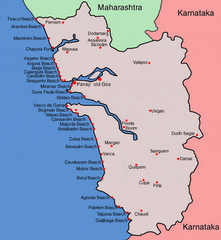Why Goa?...
From Wikipedia, the free encyclopedia(http://www.en.wikipedia.org)
Goa pronunciation (help·info) (Konkani: गोंय goṃya; Marathi: गोवा govā) is India's second smallest state in terms of area (after Delhi) and the fourth smallest in terms of population (after Sikkim, Mizoram and Arunachal Pradesh). It is located on the west coast of India, in the region known as the Konkan, and is bounded by the state of Maharashtra to the north, and Karnataka to the east and south. The Arabian Sea bounds it to the west. Panaji(Panjim) is the state's capital, and Vasco-da-Gama (Vasco) its largest city. The second largest and most historic city is Margao with the most western Portuguese culture. Portuguese merchants first landed in Goa in the 15th century, and annexed it soon after. The Portuguese colony existed for about 450 years, until it was successfully taken over by India in 1961.
Internationally renowned for its beaches, Goa is visited by hundreds of thousands of foreign and domestic tourists each year, and has become one of the most popular holiday destinations for European travellers.
Geography and climate
Goa encompasses an area of 3,702 km² (1,430 sq mile). It lies between the latitudes 14°53'54" N and 15°40'00" N and longitudes 73°40'33" E and 74°20'13" E. Most of Goa is a part of the coastal country known as the Konkan, which is an escarpment rising up to the Western Ghats range of mountains, which separate it from the Deccan Plateau. The highest point is the Sonsogor, with an altitude of 1,167 metres (3,827 feet). Goa has a coastline of 101 km (63 miles).
Goa's main rivers are the Mandovi, the Zuari, the Terekhol, Chapora and the Betul. The Mormugao harbour on the mouth of the river Zuari is one of the best natural harbours in South Asia. The Zuari and the Mandovi are the lifelines of Goa, with their tributaries draining 69% of its geographic area. Goa has more than forty estuarine, eight marine and about ninety riverine islands. The total navigable length of Goa's rivers is 253 km (157 miles). Goa has more than three hundred ancient tanks built during the rule of the Kadamba dynasty and over a hundred medicinal springs.
Most of Goa's soil cover is made up of laterites which are rich in ferric aluminium oxides and reddish in colour. Further inland and along the river banks, the soil is mostly alluvial and loamy. The soil is rich in minerals and humus, thus conducive to plantation. Some of the oldest rocks in the Indian subcontinent are found in Goa between Molem and Anmod on Goa's border with Karnataka. The rocks are classified as Trondjemeitic Gneiss estimated to be 3,600 million years old, dated by the Rubidium isotope dating method. A specimen of the rock is exhibited in the Goa University.
Goa, being in the tropical zone and near the Arabian Sea, has a warm and humid climate for most of the year. The month of May is the hottest, seeing day temperatures of over 35°C (95°F) coupled with high humidity. The monsoon rains arrive by early June and provide a much needed respite from the heat. Most of Goa's annual rainfall is received through the monsoons which last till late September.
Goa has a short cool season between mid-December and February. These months are marked by cool nights of around 20°C (68°F) and warm days of around 29°C (84°F) with moderate amounts of humidity. Further inland, due to altitudinal gradation, the nights are a few degrees cooler.
Culture
An example of traditional Goan architecture.
The most popular celebrations in Goa are Christmas, Easter Sunday Ganesh Chaturthi, New Year's Day, the Shigmo festival and the Carnival. However, since the 1960s, the celebrations of the Shigmo and carnival have shifted to the urban centres, and in recent times these festivals are seen more as a means of attracting tourists. Celebrations for all festivals usually last for a few days and include parties and balls.
Western English songs have a large following in most parts of Goa. Traditional Konkani folk songs too have a sizable following. Manddo, the traditional Goan music which originated in the nineteenth century, is sung and danced on special occasions. Goa is also known for its Goa trance music.
Rice with fish curry is the staple diet in Goa. Goa is renowned for its rich variety of fish dishes cooked with elaborate recipes. Coconut and coconut oil is widely used in Goan cooking along with chile peppers, spices and vinegar giving the food a unique flavour. Pork dishes such as Vindaloo, Xacuti and Sorpotel are cooked for major occasions among the Catholics. An exotic Goan vegetable stew, known as Khatkhate, is very popoular dish during the celebrations of festivals, Hindu and Christian alike. Khatkhate contains at least five vegetables, fresh coconut, and special Goan spices that add to the aroma of Khatkhate. A rich egg-based multi-layered sweet dish known as bebinca is a favourite at Christmas. The most popular alcoholic beverage in Goa is feni; Cashew feni is made from the fermentation of the fruit of the cashew tree, while coconut feni is made from the sap of toddy palms.
Goa has two World Heritage Sites: the Bom Jesus Basilica and a few designated convents. The Basilica holds the mortal remains of St. Francis Xavier, regarded by many Catholics as the patron saint of Goa. Once every decade, the body is taken down for veneration and for public viewing. The last such event was conducted in 2004. The Velhas Conquistas regions are also known for its Goa-Portuguese style architecture.
